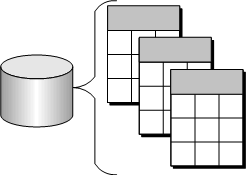In a relational database, all data is held in tables, which are made up of rows and columns.

Each table has one or more columns, and each column is assigned a specific data type, such as an integer, a sequence of characters (for text), or a date. Each row in the table has a single value for each column.
For example, a table containing employee information can look like the following:
| EmployeeID | Surname | GivenName | Phone |
|---|---|---|---|
| 102 | Huong | Zhang | 1096 |
| 10693 | Donaldson | Anne | 7821 |
The tables in a relational database have some important characteristics:
The following table lists some of the formal and informal relational database terms describing tables and their contents, together with their equivalent in non-relational databases such as dBase and FoxPro. This document uses the informal terms.
| Informal relational term | Formal relational term | Non-relational term |
|---|---|---|
| Table | Relation | File |
| Column | Attribute | Field |
| Row | Tuple | Record |
Each table in the database should hold information about a specific kind of thing, such as employees, products, or customers.
By designing a database this way, you can set up a structure that eliminates redundancy and the possible inconsistencies caused by redundancy. For example, both the sales and accounts payable departments might enter and look up information about customers. In a relational database, the information about customers is stored only once, in a table that both departments can access.
| Send feedback about this page via email or DocCommentXchange | Copyright © 2008, iAnywhere Solutions, Inc. - SQL Anywhere 11.0.0 |